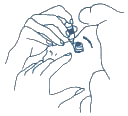Glaucoma
Glaucoma, one of the leading causes of blindness, is estimated to affect 1 of every 50 adults. Although glaucoma can occur at any age, the risk of developing the disease increases dramatically after the age of 35. Glaucoma is also more likely to develop in persons who are severely nearsighted, persons with a family history of the condition, diabetics and blacks. Because the symptoms of early glaucoma are so slight, the disease often goes unnoticed until permanent vision loss has occurred. However, with early diagnosis and careful treatment, visual damage from glaucoma can be prevented.
Glaucoma is a disease which damages the optic nerve. When light enters the eye, an image is focused onto the retina, the delicate nerve layer lining the inside back wall of the eye. The retina then transforms the light images into electrical impulses which are carried to the brain by the optic nerve. Damage to the optic nerve and retina causes blind spots in the field of vision. If the entire nerve is destroyed, blindness will occur.
Glaucoma is caused by an increase in the fluid pressure in the eye. The eye contains a clear, nourishing fluid called the aqueous which constantly circulates through the eye. Normally, this fluid leaves the eye through a drainage system and returns to the blood stream.

The fluid drainage system can be compared to a water faucet that is always turned on. Glaucoma occurs when the faucet becomes blocked, causing fluid pressure to increase. The high fluid pressure causes damage to the optic nerve, resulting in permanent vision loss. The exact reason the eye¹s drainage channel stops functioning properly is not completely understood. Much research is being done in this area to further our understanding of glaucoma.
The symptoms associated with chronic open angle glaucoma are usually unnoticeable. At first, in most cases, the build up of fluid pressure is gradual without any uncomfortable or painful symptoms. Most people do not detect a change in their vision until substantial sight loss has occurred.
 The early visual changes caused by glaucoma are slight. Certain parts of peripheral (side) vision are affected first with the top, sides, and bottom of the field of vision becoming decreased. Only late in the course of the disease is central vision affected. When left untreated, total blindness will result.
The early visual changes caused by glaucoma are slight. Certain parts of peripheral (side) vision are affected first with the top, sides, and bottom of the field of vision becoming decreased. Only late in the course of the disease is central vision affected. When left untreated, total blindness will result.
The patient stricken with acute closed angle glaucoma experiences more noticeable symptoms. The onset of acute glaucoma causes blurred vision, severe pain, nausea, and halos around lights. Congenital glaucoma also present noticeable symptoms in the infant such as enlarged eyes, cloudy cornea, light sensitivity, and excessive tearing.
 In most cases, glaucoma is detected in a routine eye examination before the patient experiences any vision problems. An evaluation for glaucoma is painless and includes several different tests. A tonometer is used to measure the pressure of the eye. The optic nerve is checked for damage with an ophthalmoscope, an instrument which illuminates and magnifies the back of the eye.
In most cases, glaucoma is detected in a routine eye examination before the patient experiences any vision problems. An evaluation for glaucoma is painless and includes several different tests. A tonometer is used to measure the pressure of the eye. The optic nerve is checked for damage with an ophthalmoscope, an instrument which illuminates and magnifies the back of the eye.
A special mirrored magnifying glass called a gonioscope is used to examine the drainage channels for proper fluid outflow. If any sign of glaucoma is detected, the patient¹s field of vision is tested for blind spots and any shrinkage in peripheral (side) vision.
 With early detection and treatment, glaucoma can be controlled and vision preserved. However, glaucoma cannot be cured and vision loss due to the disease cannot be restored. A combination of eye drops, medication, laser treatment and conventional surgery are used to treat glaucoma. Treatment is concentrated on lowering the pressure inside the eye o prevent damage to the optic nerve.
With early detection and treatment, glaucoma can be controlled and vision preserved. However, glaucoma cannot be cured and vision loss due to the disease cannot be restored. A combination of eye drops, medication, laser treatment and conventional surgery are used to treat glaucoma. Treatment is concentrated on lowering the pressure inside the eye o prevent damage to the optic nerve.
The most common treatment for glaucoma is the use of medications in the form of eye drops and pills. Some medications allow for faster drainage of fluid from the eye, while others reduce the production of fluid.
Because medications and eye drops can cause undesirable side effects or simply fail to control glaucoma, alternative methods of treatment may be needed. In some cases, painless laser treatment is performed to control glaucoma. An Argon laser is used to improve drainage and reduce fluid pressure. If other methods fail to decrease fluid pressure, conventional surgery may be required to create a new drainage mechanism.
Treatment of glaucoma is usually a life-long process, as glaucoma management requires frequent monitoring and treatment. Patients should be examined every 3 to 4 months for the rest of their lives.
It is very important to have an Eye Examination every 2 years and to be screened for Glaucoma regularly if you are over 40